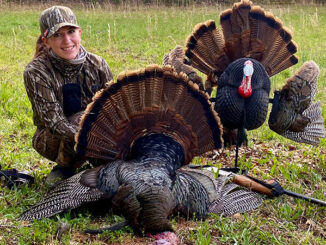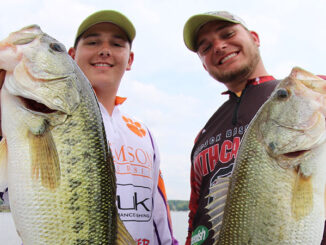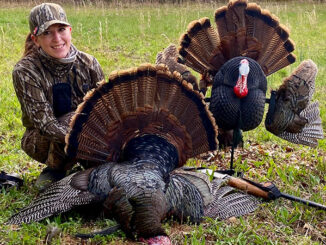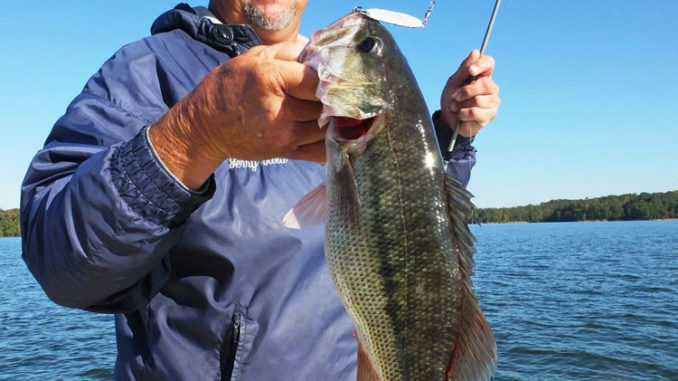
November brings great bass fishing to Lake Russell, with big spotted bass schooling up and feeding up. Here’s how to find and catch them.
Bass fishing is excellent year-round in the Carolinas, but any time the possibility exists to hook and land dozens of black bass in a day of fishing, it’s time to get the gear and go.
From mid-October though the end of the year, Lake Richard B. Russell on the Savannah River along the South Carolina-Georgia border becomes a spotted bass factory, spitting out daily catches that can reach near triple digits of black bass a distinct possibility.
The key is to identify the how, when and where to locate these aggressive bass.
Jerry Kotal, who guides for a number of species on Lake Russell, specializes in fishing for bass in November and December.
“It’s exciting and fast-paced bass fishing and likely the most-consistently productive fishing of the year for me,” Kotal said. “The key to big catches is location, location and location, because they are often schooled tight to distinct targets and are typically aggressive on the bite. Even in the cool and dropping water temperatures, we load up on quantity and quality spotted bass. I believe as the water temperature drops, the fishing actually seems to get better in late November and through December.”
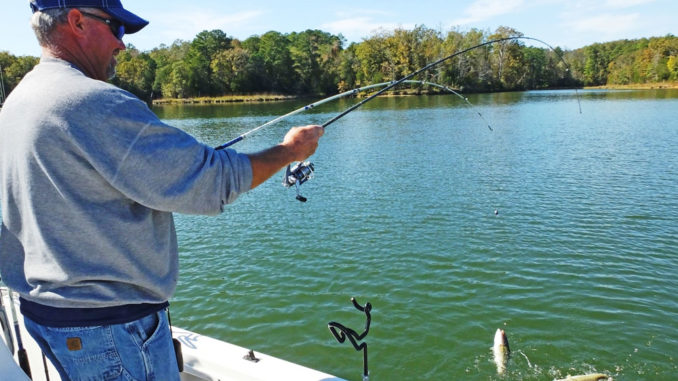
Lake Russell literally has forests of submerged standing trees, and Kotal’s preferred tactic is to find bass by using electronics on open areas not littered with trees. He searches for a three-point combination of open-water clean humps or points, bass marked on or near the bottom and forage fish graphed at mid-depths or near the bottom.
“The combination of those three factors creates ideal situations that give me high confidence,” he said. “Because of the tendency of bass to school in large groups at this time of the year we typically catch multiple bass from any given place. The most bass I’ve caught from any single target was 80 football-fat, spotted bass.”
Kotal said it’s more common to catch up to a dozen bass on a spot before the action slows and he moves to another area. As he develops the day’s pattern, it gets easier to find the next productive target. He uses a marker buoy to reference the location he’ll fish, but he doesn’t drop it right on the fish.
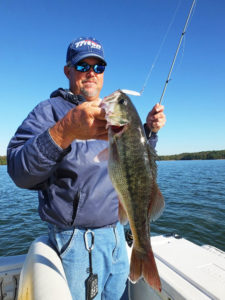
“Often, with plenty of shad in that immediate area, I won’t have to travel very far to get on another school of fish when action slows,” he said. “Wind and weather patterns influence the location, and windblown points or humps at the mouth of a cove with the wind blowing into that cove are high-priority targets for me. Any factor that tends to bunch shad into a given area has the potential to congregate bass in big numbers.”
Kotal said that while it may be easier in terms of boat control to fish on days when little when blows, some of the best fishing days are when a good chop exists on the water and funnels shad into predictable areas.
“On the windy days, it’s often easier to predict which humps, points and drops will hold fish,” he said. “The wind pushes shad into downwind coves and points, and that will typically reduce my searching. This is also where we often find larger schools of bass.”
Kotal said a reasonable day’s trip will produce anywhere from 30 to 50 bass, along with some huge white and yellow perch, but triple-digit catch days occur. The majority of the bass will be spots, but on a typical day a half-dozen largemouth are caught.
“Largemouth were originally the primary black bass species at Lake Russell, but now the spots dominate,’ he said. “But we still catch a few big largemouth bass, along with some chunky spots in the 5-pound class. Typically 1½- to 3-pound fish dominate the catch, with some pushing 4 pounds sprinkled in.
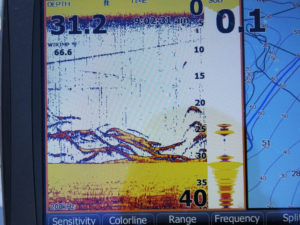
“I’ve learned what black bass targets look like on the graph, but some large white and yellow perch also congregate on these same spots,” he said. “These species mingle with bass because they’re all feeding on shad. Finding schools of shad with the presence of larger fish is a target worth fishing because bass are usually part of that scenario.”
Kotal primarily employs three lures. His top two are a ½- or ¾-ounce white Flex spoon he vertically jigs and a ½-ounce drop-shot rig dressed with a 4-inch finesse worm in watermelon, green pumpkin or watermelon seed color patterns. The third lure is a 3/4-ounce, round jighead with a brown head and brown/purple silicon skirt. Kotal usually employs the jig only for tournament fishing because it’s apt to hang up, but he said it’s lethal when targeting big spots and largemouth.
For anglers wanting to really keep the rod bent, Kotal said using live gizzard shad, blueback herring or a small shiner minnow seals the deal.
“I’ll often pull live bait when searching for bass on a large hump, and that will sometimes get a bass to bite when things are slow,” he said. “And often, once we hook one with the live bait, the bass get fired up, and the spoons and drop-shot worms become very productive. Also, the smaller shiner minnows will usually produce plenty of bites from big white and yellow perch and the occasional crappie. It doesn’t occur on every trip, but the live bait will occasionally enable us to hook a big striper, and a 20-pound-plus striper on standard bass gear elevates excitement to an elite level.”
Kotal said bass gradually slips deeper as the water cools; in November, most of the fish are in 25 to 40 feet of water, but by December, the 50-foot range is best. In the in ultra-cold water of January, fishing is still productive but generally in 60 to 80 feet of water.
Kotal’s backup plan to fishing the open, clean humps and points is working standing timber using similar techniques.
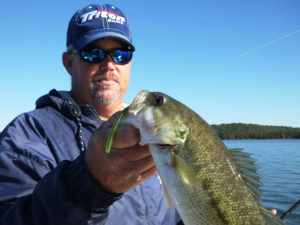
“Occasionally, the bass will just totally prefer the timber. Graphing fish targets is more difficult in the woody cover; it can be done, and this is an excellent alternative,” he said. “Most of the time, the open, clean areas produce, but I’ll go the trees when necessary. The trees and limbs make it more difficult to fish, but find the shad and mark fish, and you’ll usually get bass to bite.”
“A lot less fishing pressure exists this time of the year, and even with the sensational bass fishing, the lake has few fishermen, especially during the weekdays,” Kotal said. “A lot of outdoorsmen are deer hunting or after small-game species once those seasons arrive. But the bass fishing is dependable, fast-paced and fun.”
DESTINATION INFORMATION
HOW TO GET THERE — Lake Russell lies on the Georgia-South Carolina line, southwest of Abbeville in Anderson and Abbeville counties. SC 81 and SC 72 provide the best access. Top public ramps are Milwood, southwest of Calhoun Falls off SC 81; Calhoun Falls State Park off SC 81; Beer Garden Creek, south of Calhoun Falls of SC 81; Blue Hole, west of Calhoun Falls of SC 81; Felkel, southwest of Lowndesville off CR 74; Wilson Creek, north of Lowndesville off CR 72; Allen Creek, west of Lowndesville, off CR 70.
WHEN TO GO — Mid-October through December are prime times to fool Lake Russell’s spotted and largemouth bass.
BEST TECHNIQUES — Fish a white Flex spoon or a drop-shot rig on humps. Look to mark bass and baitfish over the hump before you drop down a bait. Bass are likely to be in tight schools late in the fall, first 25 to 40 feet deep, then in 50 feet of water as December arrives.
FISHING INFO/GUIDES —Jerry Kotal, Jerry Kotal’s Fishing Guide Service, 706-988-0860, www.jerrykotalsfishingguideservice.com; Wendell Wilson, Wilson’s Guide Service, 706-283-3336; www.wilsonsguideservice.com. See also Guides and Charters in Classifieds.
ACCOMMODATIONS — Econo Lodge, Elberton, Ga., 888-690-5281; Days Inn, Elberton, Ga., 800-230-4134; Calhoun Falls State Park camping, 864-447-8267; www.southcarolinaparks.com/calhounfalls/camping.aspx.
MAPS — Kingfisher Maps, 800-326-0257, www.kfmaps.com; Delorme South Carolina Atlas & Gazetteer, 800-561-5105, www.delorme.com.

